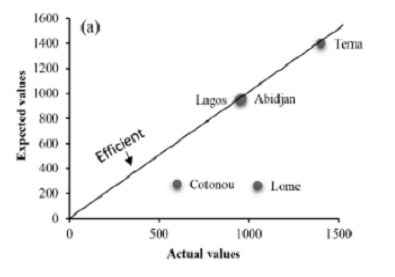


Indian Journal of Science and Technology
DOI: 10.17485/IJST/v14i46.1755
Year: 2021, Volume: 14, Issue: 46, Pages: 3396-3406
Original Article
Gloria Boakye1, Yu Li1*, Esther Asare2
1Computer Science and Engineering, Anhui University of Science and Technology, Huainan232001, China
2Mathematics and Big Data, Anhui University of Science and Technology, 232001, Huainan, China
*Corresponding Author
Email: [email protected]
Received Date:17 October 2021, Accepted Date:12 December 2021, Published Date:24 December 2021
Background: Ports are one of the assets of every country and one way to achieve efficiency is by maximizing productivity amid limited resources. Despite the increase in the number of studies on the efficiency of container terminals, their focus has been channeled on advanced markets. Researchers conduct limited studies on container terminals in developing countries such as those of the West African region, which are located in a critical geographic place in the international maritime route between these areas and the World. Information on their potential for development relative to other terminals worldwide is therefore not readily available hence, this study seeks to provide answers to critical productivity indicators of ports in the West Africa sub-region. Methods : We evaluate the technical efficiency of the 5 major container terminals in the West African region. The Data Envelopment Analysis (DEA) approach is used to measure technical efficiency and slack variable analysis which identifies potential areas of improvement for inefficient terminals. Moreover, DEA can handle multiple inputs and outputs, which makes it applicable to the port analysis. Findings: The results indicate that the Tema port is the most efficient port among the sample, with an average efficiency of 100% in the nine years and the Port of Cotonou is the least efficient with an average efficiency of 44% and exhibits substantial waste in production throughout the nine-year analysis. Novelty: This is the first time that the current data from 2010- 2018 has been used to determine port efficiency and the efficiency scores are necessary indicators for terminal managers to adopt and sustain all the necessary alignments to structures and strategies.
Keywords: Data envelopment analysis; productivity improvement; efficiency; port management; West Africa
© 2021 Boakye et al. This is an open-access article distributed under the terms of the Creative Commons Attribution License, which permits unrestricted use, distribution, and reproduction in any medium, provided the original author and source are credited.
Published By Indian Society for Education and Environment (iSee)
Subscribe now for latest articles and news.